Canon EOS C70 Cinema Camera with RF 24-105mm F2.8 L IS USM Z and Power Zoom


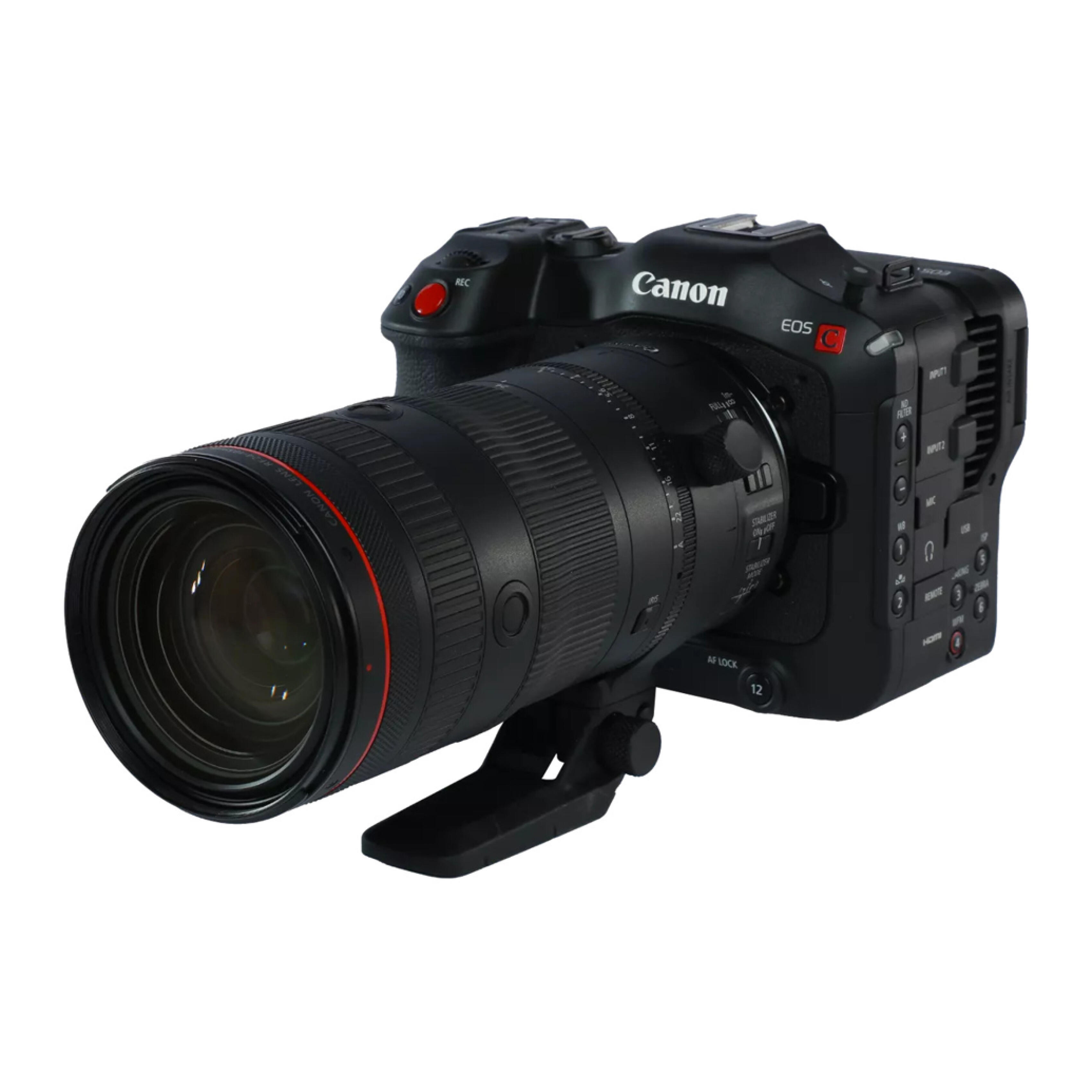


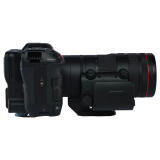
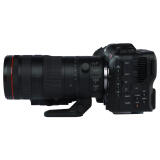


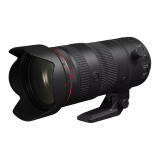
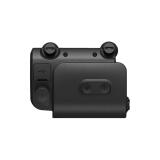
- Canon Super 35mm Dual Gain Output (DGO) Sensor, 16+ stops of Total Dynamic Range
- DIG!C DV7 Image Processor
- Canon Log 2 and 3, PQ, and HLG Recording
- RF Mount
- EF Lens Compatibility with Mount Adapter EF-EOS R 0.71x
- Direct Touch Control
- Approved for use in Netflix productions
- World’s first 24-105mm focal length combined with consistent f/2.8 maximum aperture1
- Supports optional Canon Power Zoom Adapters
- 11 aperture blades
- Smooth, click-less iris ring for precise lens aperture control
- Close-focusing to under 1.5 feet (0.45m) at all focal lengths
- Maximum magnification 0.29x at the 105mm zoom setting
- Optical Image Stabilization up to 5.5 stops of shake correction and Coordinated Control (IS up to 8.0 stops with cameras equipped with IBIS)3
- Nano USM maintains focus while zooming.
Developed with an idea of combining the Cinema EOS series with the EOS R series, the new EOS C70 offers exceptional image quality and professional video features in a compact and mobile form factor, perfect for documentary, newsgathering, and corporate videos.
The EOS C70 is the first Cinema EOS camera with a built-in RF-lens mount, which was previously a feature that was only used for the EOS R series of mirrorless cameras. The RF-mount offers users access to Canon's superb line of RF-lenses, which are quick, reliable and provide brilliant image quality. There is also a full 2, 4, 6, 8, and 10-stop internal ND filter system in the relatively small flange depth of the RF-mount.
Canon's EOS C70 is also equipped with a Super 35mm Dual Gain Output (DGO) Sensor that is capable of over 16 stops of dynamic range. The DIG!C DV7 Image Processor expands functionality and flexibility by enabling features such as 4K 120p High Frame Rate recording and Dual Pixel Autofocus.
Canon Super 35mm Dual Gain Output (DGO) Sensor, 16+ stops of Total Dynamic Range
The

The DGO Sensor is a newly developed imaging system that generates high dynamic range and maintains low noise levels by reading out each photodiode with two different gains. It combines the two with a saturation prioritizing gain for bright areas, and a lower noise prioritizing gain for darker areas.

DIG!C DV7 Image Processor
The EOS C70 features Canon's DIG!C DV7 image processor that takes the extensive RAW information captured from the imaging sensor and processes it for output. DiG!C is also the engine behind features such as high frame rate recording, Dual Gain Output (DGO) Sensor, Dual Pixel Autofocus, HDR (PQ) output, Electronic Image Stabilization, and proxy recording.
Canon Log 2 and 3, PQ, and HLG Recording
The EOS C70 supports both Canon Log 2 and Canon Log 3 Gamma. In post-production, Canon Log is designed to reproduce the entire tonal range that the CMOS image sensor is capable of. Log workflows provide the user with higher dynamic range, more highlight and shadow retention, and more flexibility in color grading.
Canon Log 2 provides the largest dynamic range and image detail. However, while Canon Log 2 provides the most post-production flexibility and full dynamic range of the sensor, it typically requires more time in post and color correction.
For users looking for most of the benefits of a log workflow, but with shorter turnaround times, Canon Log 3 provides an alternative with only a slightly reduced dynamic range of 14 stops.
The EOS C70 also features HLG and PQ compliance with ITU-BT.2100 in Custom Picture (CP) presets, allowing users to record HDR footage instantly without grading.
RF Mount
The EOS C70 is the first Cinema EOS camera engineered with a built-in RF mount making it compatible with Canon’s expanding line of high-performance RF lenses. The short flange distance helps to dramatically reduce body depth, resulting in a more compact design.
EF Lens Compatibility with Mount Adapter EF-EOS R 0.71x
In addition to RF lenses, the EOS C70 offers tremendous flexibility by also being compatible with Canon's broad line of award-winning EF lenses thanks to the new EF - RF optical adapter, Mount Adapter EF-EOS R 0.71x. This adapter converts light transmission from full-frame to Super 35mm image format. It extends the angle of view and optical sensitivity, while seamlessly integrating with the camera’s optical corrections.
The adaptor connects to the camera’s RF mount with additional support from two flanges that securely attach via four screws, making for a very robust connection. Once mounted, the adapter maintains a similar full-frame angle of view on the Super 35mm sensor, while boosting the speed of the attached lens by an average of 1-stop. The adapter also carries all EF information through to the RF contacts, so on certain lenses, full DPAF, aberration and vignetting correction, and metadata will be available, working just as they do on a native EF mount.
Direct Touch Control
The EOS C70 is equipped with Direct Touch Control which allows easy access to commonly used menu settings on the fully-rotatable LCD screen. Users will be able to simply touch the screen to start/stop recording, access file format and resolution, set ISO/Gain, color temperature and iris, and display important settings. Shooting settings that were once in various places of the menu can now be accessed with one hand, allowing for on-the-spot changes while holding the camera.
9x16 Vertical Shooting
The EOS C70 supports vertical shooting, which is crucial for creators looking to capture content for smart devices and digital signage. The user interface can be switched to support vertical shooting with the same feel as horizontal shooting. A 1/4/20 tripod hole is built into the side of the camera grip, allowing users to easily attach a tripod without special accessories.
New Compact, Uni-Body Design
The EOS C70 features a new uni-body design that exhibits a compact form factor and an ergonomic built-in grip making handheld shooting easy and comfortable.
Built-in Mini-XLRS
The EOS C70 is equipped with two mini-XLR audio input terminals for professional audio recording. Additionally, manual audio control dials let users intuitively and quickly adjust the audio control.
Built-in Neutral Density Filter System
The newly-developed thin, motorized ND filter unit has been specifically designed for the RF mount's short flange back. It offers up to 10 stops of ND, allowing users to shoot in various lighting conditions.
Time Code Terminal
The EOS C70 includes a time code input/output terminal in the lower front of the body that makes synchronizing easier in multi-camera productions.
Dual Pixel CMOS AF, EOS iTR AF X, Dual Pixel Focus Guide
Canon's Dual Pixel CMOS AF technology uses every pixel on the imaging sensor to detect focus and to capture actual image information, offering users high precision focusing and exceptional image quality.
The
The
Electronic Image Stabilization with Coordinated Control
For the first time in a Cinema EOS camera, enhanced image stabilization is available with coordinated control. With an RF lens and the electronic IS in the EOS C70 , coordinated control optimizes hand-shake correction, resulting in better anti-vibration performance than the conventional EF lens and electronic IS together.
In addition, the EOS C70 adds Super 16 Digital IS, which stabilizes the 2K images by using the peripheral area around the center of the 4K sensor, to provide high performance stabilization.
Auto ISO/Gain Control
The EOS C70 is the first Cinema EOS camera to feature Auto ISO and Gain Control. EOS C70 can automatically adjust sensitivity by utilizing the DGO sensor characteristics to switch gain smoothly, helping users concentrate on framing without worrying about aperture and other camera settings when moving from indoor to outdoor locations with significant changes in lighting.
RC-V100 Remote Control Support
The EOS C70 features a remote terminal that allows users to control the camera with Canon's RC-V100. The multi-functional RC-V100 remote controller provides full access to all important functions, including start/stop, shutter/gain adjustments, zoom/focus/iris parameters, custom picture values, white balance, black gamma, and more.
Dual SD Card Slots with Various Recording Options
The EOS C70 has dual SD card slots for simultaneous recording in different formats, including 4K/HD and XF-AVC/MP4.
High Frame Rate; 4K 120P and 2K CROP 180P
The
Long GOP Supported in 4K/2K
The EOS C70 supports Long GOP with high compression for longer recording times up to 4K 60P. This inter-frame compression method detects differences between frames by referring to preceding and subsequent frames.
RF24-105mm F2.8 L IS USM Z Overview
The RF24-105mm F2.8 L IS USM Z is the world’s first 24-105mm focal length lens combined with consistent f/2.8 aperture.1 With its constant f/2.8 max aperture, full-frame coverage, and its ability to zoom past the traditional 70mm roadblock to a true portrait-length 105mm, this lens is an incredible standard zoom solution for many different applications. Even in low light, this lens will excel for weddings and events, photojournalism, portraiture, studio work, and video creation.
Features
Outstanding Optical Performance with Consistent f/2.8 Maximum Aperture
By taking advantage of the large diameter RF mount and short back focus, the RF24-105mm F2.8 L IS USM Z is able to achieve a maximum aperture of f/2.8 throughout its entire zoom range. This enables you to continuously shoot up to the frequently used 105mm without switching lenses, opening a world of possibilities for both photo and movie shooting.
Eleven Aperture Blades for Rich Bokeh
With eleven aperture blades and a large f/2.8 aperture, the RF24-105mm F2.8 L IS USM Z produces a beautiful, almost circular bokeh effect — even when stopped-down. The wide aperture also allows for faster shutter speeds in low light situations and helps prevent subject blurs.
Iris Ring for Precise Lens Aperture Control
The RF24-105mm F2.8 L IS USM Z is equipped with an iris ring (aperture control), the first among RF lenses2. This allows video users to manually control exposure adjustment and the degree of background blur while shooting video, with click-less, smooth operation — similar to the operability in a cinema lens.
Close-focusing to Under 1.5 ft., Max. Magnification 0.29x
With a minimum focusing distance of approximately 1.5 ft./0.45m, the RF24-105mm F2.8 L IS USM Z lens helps you get close to your subjects. The maximum magnification is 0.29x at 105mm, allowing you to capture subtle details more expansively and clearly. Focus shifts during zooming are minimal — plus, it supports focus breathing correction3, in which the camera digitally corrects for changes in angle of view caused by focus movement during video recording, especially during closeup shooting.
Optical Image Stabilization
For consistently sharp results, the RF24-105mm F2.8 L IS USM Z features built-in optical Image Stabilization, providing enhanced shake reduction for up to 5.5 stops of shake correction. When paired with an EOS R-series camera that has In Body Image Stabilization (IBIS), the Coordinated IS allows for up to 8.0 stops of correction4. This means more reliable handheld performance and clear detail in low-light situations, without having to increase the ISO or decrease the shutter speed. Additionally, an IS Mode switch is featured for the first time among Canon RF standard zoom lenses.
Nano USM Maintains Focus While Zooming
The RF24-105mm F2.8 L IS USM Z features two Nano USM (ultrasonic motors) focus drive system, powering both its autofocus, and its “floating” optics which move independently to ensure maximum image quality. Nano USM provides quiet and smooth AF, especially useful during movie recording. In addition, the Nano USM maintains focus while zooming to suppress aberration fluctuations during high-speed burst or movie shooting.
Excellent Handling
With its fixed-length lens barrel design and balanced center of gravity, the RF24-105mm F2.8 L IS USM Z provides excellent handling for any shooting style and especially advantageous when using accessories for shooting video. The lens comes with a tripod mount that can be easily attached and detached with a lock release button, without the need of a special tool. Also available is the LH-E1 lens holder (sold separately), which supports the lens when combining with a rig.
Durable and Dependable Build
The RF24-105mm F2.8 L IS USM Z boasts amazing durability and endurance you’d expect from an L-series lens. The lens barrel does not move during zooming or focusing; both are achieved entirely internally. Weather-resistant sealing is applied to areas such as the operation rings and switch panel to help prevent water and dust from entering the unit. Fluorine coating is applied on the front lens to prevent water, oil and other surface residue like fingerprints from sticking to the lens, which facilitates quick and easy wiping without the use of solvents. This dust- and water-resistant design allows for outstanding performance even in inclement weather conditions.
Sophisticated Zoom Control
Power Zoom Adapter PZ-E2B enables smooth, high-precision zoom control during movie shooting. Featuring a DC motor that provides both rapid zoom action and smooth, low-speed zooming, the PZ-E2B allows for unassisted single-person video shooting operation.
Zoom Speed Adjustment Dial
Easily control zoom speed via a stepless adjustment dial located at the front of the Power Zoom Adapter. Zoom speed can be finely tuned for precision and operability that satisfies the needs of videographers.
Excellent Operability
Easily attach and detach the Power Zoom Adapter PZ-E2B without the use of a special tool*. Simply line up the positioning pins with the sockets on the RF24-105mm F2.8 L IS USM Z lens and turn the mounting screws to fasten the adapter. The placement was designed so it can be attached or detached even while the lens is combined with a rig, gimbal, or tripod so you can keep your production rolling. A thumb rest attachment is also included for additional hand-held comfort.
* A hexagonal allen-type wrench is bundled for attaching/detaching the thumb rest.
Supports Various Shooting Styles
The Power Zoom Adapter PZ-E2B can be used in various ways depending on the videographer’s shooting style or system configuration. Manual operation of zooming is achieved using the switches on the main unit, camera-side operation is possible via assigning custom buttons**, controller operation via the 20-pin port, or remote operation via Canon EOS Utility software or Camera Connect app.
In the Box
- Canon EOS C70 Camera Body
- Handle Unit
- SS-1200 Shoulder Strap
- Battery Charger CG-A20
- Compact Power Adapter CA-CP200 L
- AC Power Cable US
- Canon BP-A30 Battery Pack
- Microphone Holder Unit
- Shoe adapter Base/Knob/Screw (M4)
- Measure Hook
- Body Cap
- RF 24-105mm F2.8 L IS USM Z Lens
- Lens Cap E-82II
- Lens Hood EW-88E
- Lens Case LZ1326(B)
- Lens Dust Cap RF
Brand

camera attributes
| Image Sensor Size | 26.2 x 13.8 mm (Super35) |
| Lens Mount | Canon RF |
| Image Sensor Type | CMOS |
| ISO Sensitivity | 100 to 102,400 |
| Exposure Compensation | -6 to 54 dB (Native) -2 to 54 dB (Expanded) |
| Shutter Speed (Video) | 1/12 to 1/2000 sec (In 60p Mode) 1/15 to 1/2000 sec (In 50p Mode) |
| Built-In Microphone | Stereo, Mono |
| Maximum Resolution | Actual: 4206 x 2280 (9.6 MP) Effective: 4096 x 2160 (8.85 MP) |
| Audio Recording | 4-Channel 24-Bit 48 kHz LPCM Audio |
| Operating Temperature | 32 to 104°F / 0 to 40°C (Recommended) |
| Recording Pixels / Frame Rate | DCI 4K: 12 Up to 120 fps DCI 2K (Windowed): 12 Up to 180 fps |
| External Recording Modes | 4:2:2 10-Bit via HDMI: 4096 x 2160p at 23.98/24/25/29.97/50/59.94 fps 3840 x 2160p at 23.98/24/25/29.97/50/59.94 fps 1920 x 1080p at 23.98/24/25/29.97/50/59.94 fps 2048 x 1080p at 23.98/24/25/29.97/50/59.94 fps 1280 x 720p at 23.98/24/25/29.97/50/59.94 fps |
| Camera Body Weight | 2.58 lb |
| Shutter Type | Rolling Shutter |
| Monitor Size | 3.5" |
| Recording Media | 2 x SDXC/SDHC Card Slots |
image sensor
| Color Filter System | Bayer |
physical specifications
| Weight | 2.58 lb / 1.17 kg (Body Only) 2.95 lb / 1.34 kg (With Battery) |
| Dimensions | 6.3 x 5.1 x 4.6" |
power system
| Battery Type | Canon BP-A Series |
detailed specifications
| Connectors | 2 x Mini XLR Mic/Line Level (+48 V Phantom Power) Input 1 x 1/8" / 3.5 mm Stereo Input 1 x 1/8" / 3.5 mm Stereo Headphone Output |
| Connectors | 1 x HDMI Output |
lens specification
| Lens Aperture | F/2.8 |
display & viewfinder
| Display Type | Articulating LCD |
brand
| Brand | Canon |